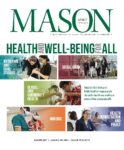If you haven’t been to Mason in a while, you might not recognize it. And living on campus, well, it’s changed quite a bit.
When people hit 35, they’re most likely on the lookout for the beginning of a spare tire. When George Mason University hit that milestone last year, it also found itself expanding—in enrollment, degree programs, buildings, and amenities.
In terms of dining options, residence halls, computer labs, and laundry facilities, Mason is light years ahead of where it was three-and-a-half decades ago. A lot of that growth has been driven by the need for more facilities for resident students. Far from being a so-called commuter school, Mason is now home to nearly 5,000 students, the same on-campus population found at Harvard, Princeton, or Yale.
Residence Halls

Residence halls, then and now.
THEN: The first dorms on the Fairfax Campus were completed in October 1977. The apartment-style units behind Thompson Hall housed 498 students. In 1984, the Patriot Village modules, intended as temporary housing, were constructed: 17 modules and 100 suite-style housing units that usually held the maximum occupancy of 226 students.
NOW: Patriot Village has been dismantled after nearly 25 years of almost constant use. And while the moment was bittersweet for many alumni with fond memories of that special spot, Mason’s made way for bigger and better housing options. Namely, the opening of the Northeast Sector, a collection of seven new buildings that more than 1,000 students call home.
The $75 million project added another 450,000 square feet of living, dining, and recreational space to the Fairfax Campus. Much more than just residence halls, the development is patterned after an urban neighborhood, with assorted retail shops, restaurants, and a fitness center, all linked by a pedestrian mall.
Dining

Dining halls, then and now.
THEN: Mason’s first cafeteria, called the Ordinary, was located in the basement of the South Building, now Krug Hall. Situated just below the chemistry labs, acrid fumes often seeped down to the dining area, mingling the smell of sulfur with the aroma of cafeteria fare. In 1974, the Student Union, now identified as Student Union Building I or SUB I, was born.
NOW: Southside, a collection of six dining stations, opened this fall in the Northeast Sector, the university’s newest neighborhood. From burgers at 4400 Grill to hand-dipped ice cream at After All, diners are presented with a bevy of cuisine options. But don’t say food court: The ambiance is more bistro than fast-food restaurant. From 7:30 a.m. to 8 p.m., fresh dishes are available—some made to order right in front of the diner. The new facility seats up to 537 people, with both indoor and outdoor seating.
And for those who can’t live without a good jolt of caffeine, a full-service Starbucks arrived in the Chesapeake neighborhood this year with generous 7:30 a.m. to 2:30 a.m. hours, accommodating both early birds and night owls. These new additions bring Mason’s dining options to 24. But say arrivederci to Ciao Hall—it closed up shop to make way for Southside.
One of the most popular eateries on campus is Ike’s, located in the Presidents Park residential complex. The 1950s-style diner serves typical diner grub until 4 a.m. on weekdays so students never go hungry.
Computers

Computer labs, then and now.
THEN: The university’s first computers arrived in the late 1970s, but it wasn’t until the late 1980s that they—and their dot matrix printers—could be found on desktops throughout campus.
NOW: You can’t swing an Ethernet cable without hitting a PC or Mac. Labs, outfitted with nearly 400 computers for student use, are situated on all campuses; some on the Fairfax Campus are open 24 hours. Plus, eight buildings host E-mail Express computers—perfect for a quick virtual check-in for active students. In addition, most buildings on campus are equipped with wireless Internet service, so it isn’t unusual to see tables of students working on laptops while eating and socializing in the Johnson Center.
Mason’s resident technicians, or ResTechs, help on-campus students with computer issues. These student workers are available in the residence life areas every evening during the school year to troubleshoot technical issues with personal computers.
And once again Mason is on the cutting edge. The university is part of a statewide initiative to create a virtual computing lab that will enable students to access the software applications they need anytime, anywhere, eliminating the need to dedicate rooms to computer stations.
Laundry
THEN: Save up your quarters for months. Then wait for off-peak hours to do your laundry so you don’t have to fight the crowds. Cross your fingers that someone won’t take your clean clothes out of the dryer and leave them in the dusty recesses of the laundry room.
NOW: To eliminate the loose change hassle, Mason has adjusted its housing rates to include laundry fees. Washers and dryers are located in every residential building, and townhouses actually have a set in every unit.
In 2006, the university launched a new online laundry system called E-Suds. Residents can check online to see whether washers and dryers are open in their building. They can also use their Mason ID to activate the machines and then receive notification via e-mail or text message when the cycle is complete. Isn’t technology grand?
Roommates

Roommates, then and now.
THEN: Try to ignore the roommate horror stories you’ve heard and hope you’ll get paired with someone who’s sane.
NOW: With the Living and Learning Communities, also known as LLCs, floor mates are matched by their common interests. LLCs are residential floors and academic communities designed to expand learning beyond the classroom. National studies show that students who participate in such living arrangements tend to become more involved in their communities, have more academic success, and adjust more quickly to the demands of living at a large university. A number of communities are available, including the Green Floor, Cultural Passports, and Healthy Living.

No Comments Yet »
Leave a comment